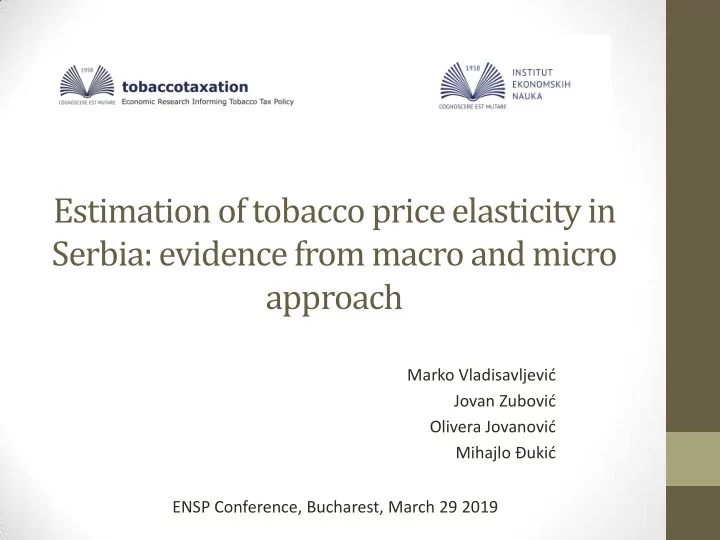

Estimation of tobacco price elasticity in Serbia: evidence from macro and micro approach Marko Vladisavljević Jovan Zubović Olivera Jovanović Mihajlo Đukić ENSP Conference, Bucharest, March 29 2019
Tobacco price elasticity • Tobacco taxation is one of the main instruments in tobacco control • The effectiveness of tobacco taxation depends on the consumers response to price increase, i.e. tobacco price elasticity • Previous research • High-income countries: -0.25 to -0.5 (Chaloupka et al., 2012) • Low and middle-income countries: -0.5 to -1 (John, 2008; Chaloupka et al. 2000) 2
Serbia • High prevalence: 29.2% of daily smokers (18.4% EU) • Up to 38% when occasional smokers are included • Low prices …: average € 2.05 per pack (vs. average € 4.8 EU) • … and taxes: average € 1.25 per pack (vs. minimum € 1.8 EU) • Strong perceived importance of multinational tobacco producers • three major privatizations of tobacco companies and one Greenfield investment within the last 15 years • hub for cigarette production in the region • export of cigarettes increased by ten-fold since 2007 Government support, including but not limited to, the policy of gradual (rather than sharper) increase of the excise duties 3
Main aim - elasticity estimation • Two models • ECM model – uses aggregate – time series (2002-2017) • Deaton’s model (Deaton, 1988) – uses household budget expenditure data (2012-2016) • Limitations ECM model Deaton’s model Short time series (15 Underreporting observations) Estimating at intensive margin Not capturing illicit trade only No distinction between the intensive and intensive margin For both models we use proxy for income ECM – GDP per capita; Deaton – Total household consumption 4
ECM model (variables) Cons t = α + β 1 Price 1t + β 2 Income 2t + β 3 Law 3t + ε t (1) Variables used in the model (2002-2016) • Cigarettes consumption per adult (15+ in packs): retail sales volume and demographic trends (SORS) • Real tobacco price index (CPI): deflating nominal tobacco CPI by general CPI (SORS) • Real income: gross domestic product (GDP) per capita (SORS) • Tobacco control policies: • ban on tobacco advertising (1=2010/16, 0 otherwise) 5
ECM model (variables) Cons t = α + β 1 Price 1t + β 2 Income 2t + β 3 Law 3t + ε t (1) Consumption GDP and price 250 6000 5000 200 4000 150 3000 100 2000 50 1000 0 0 Real GDP per capita Consumption (packs per adult) Price (real tobacco CPI) 6
ECM model (results) Cons t = α + β 1 Price 1t + β 2 Income 2t + β 3 Law 3t + ε t (1) • Cons, Price and Income are I(1) level variables • Johansen cointegration test suggests that the variables in the cointegration relation are stationary, so we can estimate the model Cons t = α + -0.699 *Price 1t + 0.015 *Income 2t + -20.07 Law 3t + ε t • From equation (1) we calculate the price and income elasticity and use bootstrapping procedure to confirm their significance • Estimated elasticities are • Price: -0.598 (0.215) • Income: 0.397 (0.009) • ECM model suggests that the consumption is adapting to the cointegration relation very fast (0.957) • 95.7% of deviation from long-run equilibrium will be corrected in the following year 7
Deaton’s model • Household expenditure data typically do not contain prices • Deaton’s (1988) model • model of consumer choice, uses the ratio between consumption and quantity to calculate unit value of cigarettes , which is a proxy for prices • It is a three-stage model which utilizes regional and time variation in budget shares and unit values to estimate the price elasticity • Model controls for household total consumption , household size and other household characteristics (gender, age, education, settlement) • We use Household Budget Survey data from 2012 to 2016 • We restrict the sample to household with positive tobacco consumption 8
Deaton’s model • First stage: control for household level characteristics • 𝑥 ℎ𝑑 = 𝛽 0 + 𝛾 0 𝑚𝑜𝑦 ℎ𝑑 + 𝛿 0 . 𝑨 ℎ𝑑 + 𝜾𝒎𝒐𝒒 𝒅 + 𝑔 0 𝑑 + 𝑣 𝑑ℎ 1 • 𝑚𝑜𝑤 ℎ𝑑 = 𝛽 1 + 𝛾 1 𝑚𝑜𝑦 ℎ𝑑 + 𝛿 1 . 𝑨 ℎ𝑑 + 𝝎𝒎𝒐𝒒 𝒅 + 𝑣 ℎ𝑑 = 𝜔 −1 𝜄 • Second stage: estimate 𝜚 0 = 𝛽 0 + 𝜄𝑚𝑜𝑞 𝑑 + 𝑔 0 • 𝑧 𝑑 𝑑 + 𝑣 𝑑 1 −𝜏 0 , 𝑧 01 /𝑜 𝑑 𝑑 𝑑 𝑑𝑝𝑤 𝑧 = 𝜚 1 = 𝛽 1 + 𝜔𝑚𝑜𝑞 𝑑 + 𝑣 𝑑 + 1 • 𝑧 𝑑 var ( 𝑧 1 )−𝜏 11 /𝑜 𝑑 𝑑 • Third stage: via weak separability assumption (Deaton, 1997) 𝜄 can be estimated as 𝛾 1 𝜄 = 𝜚/[1 + 𝑥 − 𝜚 𝜂] where 𝜂 = 𝛾 0 +𝑥(1−𝛾 1 ) 𝜄 9 0 𝛾 1 + ( 𝜗 𝑦 = 1 − 𝛾 𝑥 ) 𝜗 𝑞 = − 𝜔 𝑥
Deaton’s model (results) • We use bootstrapping procedure to estimate the standard errors • Price elasticity ξ p = -0.450; SE ξp = 0.065, t = -6.923 • Income elasticity ξ i = 0.532 • These are elasticities on the intensive margin! 10
Conclusions Price elasticity Income elasticity ECM model -0.598 0.397 Deaton’s model -0.450 0.532 (intensive margin) • Price elasticity in Serbia is negative and inelastic which indicates that higher taxes on tobacco would 1. decrease tobacco demand and lower the harmful health effects 2. increase the government revenues from tobacco taxation • Abolishment of the gradual excise calendar and more dynamic increase of excises should be an imperative • Further research is needed 11
E-mail: marko.vladisavljevic@ien.bg.ac.rs THANK YOU FOR YOUR ATTENTION 12
Recommend
More recommend